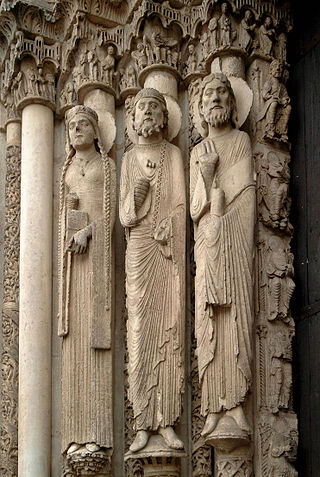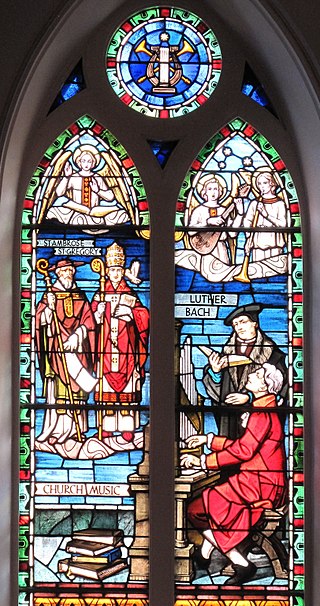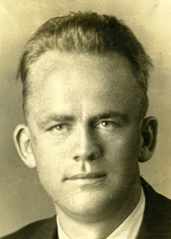
Stained glass is coloured glass as a material or works created from it. Although traditionally made in flat panels and used as windows, the creations of modern stained glass artists also include three-dimensional structures and sculpture. Modern vernacular usage has often extended the term "stained glass" to include domestic lead light and objets d'art created from foil glasswork exemplified in the famous lamps of Louis Comfort Tiffany.

Julius Schnorr von Carolsfeld was a German painter, chiefly of Biblical subjects. As a young man he associated with the painters of the Nazarene movement who revived the florid Renaissance style in religious art. He is remembered for his extensive Picture Bible, and his designs for stained glass windows in cathedrals.

Gothic art was a style of medieval art that developed in Northern France out of Romanesque art in the 12th century AD, led by the concurrent development of Gothic architecture. It spread to all of Western Europe, and much of Northern, Southern and Central Europe, never quite effacing more classical styles in Italy. In the late 14th century, the sophisticated court style of International Gothic developed, which continued to evolve until the late 15th century. In many areas, especially Germany, Late Gothic art continued well into the 16th century, before being subsumed into Renaissance art. Primary media in the Gothic period included sculpture, panel painting, stained glass, fresco and illuminated manuscripts. The easily recognizable shifts in architecture from Romanesque to Gothic, and Gothic to Renaissance styles, are typically used to define the periods in art in all media, although in many ways figurative art developed at a different pace.

The Cathedral Basilica of the Immaculate Conception is the cathedral of the Archdiocese of Denver of the Roman Catholic Church. It is located at the corner of Logan Street and Colfax Avenue in the North Capitol Hill neighborhood of central Denver.

Franz Mayer of Munich is a German stained glass design and manufacturing company, based in Munich, Germany and a major exponent of the Munich style of stained glass, that has been active throughout most of the world for over 170 years. The firm was popular during the late nineteenth and early twentieth century, and was the principal provider of stained glass to the large Roman Catholic churches that were constructed throughout the world during that period. Franz Mayer of Munich were stained glass artists to the Holy See and consequently were popular with Roman Catholic clients. The family business is nowadays managed by the fifth generation and works in conjunction with renowned artists around the world.

Leadlights, leaded lights or leaded windows are decorative windows made of small sections of glass supported in lead cames. The technique of creating windows using glass and lead came to be known as came glasswork. The term 'leadlight' could be used to describe any window in which the glass is supported by lead, but traditionally, a distinction is made between stained glass windows and leadlights; the former is associated with the ornate coloured-glass windows of churches and similar buildings, while the latter is associated with the windows of vernacular architecture and defined by its simplicity.

A revival of the art and craft of stained-glass window manufacture took place in early 19th-century Britain, beginning with an armorial window created by Thomas Willement in 1811–12. The revival led to stained-glass windows becoming such a common and popular form of coloured pictorial representation that many thousands of people, most of whom would never commission or purchase a painting, contributed to the commission and purchase of stained-glass windows for their parish church.

Clayton and Bell was one of the most prolific and proficient British workshops of stained-glass windows during the latter half of the 19th century and early 20th century. The partners were John Richard Clayton (1827–1913) and Alfred Bell (1832–1895). The company was founded in 1855 and continued until 1993. Their windows are found throughout the United Kingdom, in the United States, Canada, Australia and New Zealand.

Saint Stanislaus Kostka Catholic Church is a historic Polish church of the Roman Catholic Archdiocese of Chicago that is located at 1351 West Evergreen Avenue in the Pulaski Park neighborhood of Chicago, Illinois, United States. It is designated as the Sanctuary of Divine Mercy of the Archdiocese.
Willet Hauser Architectural Glass, Inc is a North American stained glass firm located in Winona, Minnesota, that specializes in the design, fabrication, preservation and restoration of leaded stained glass and faceted glass windows.

Trinity Parish Church is a historic church located in the First Hill neighborhood of Seattle, Washington, that was added to the National Register of Historic Places in 1991. It is an Episcopal congregation in the Diocese of Olympia.

William Holland was a 19th-century British maker of stained glass and other decorative pieces. His work is represented in churches and stately homes across England, Wales, and Ireland. Holland of Warwick windows can be identified by his mark "Guil Holland Vaivic. Puix " written on a scroll in Latin in the lower right hand corner. Holland's stained glass reflects the influence of the Cambridge Camden Society and the Gothic Revival work of Thomas Willement. Willement revived in the early 19th century, the method used at York Minster to build the Great East Window in 1400 wherein coloured pieces are leaded and the lead then becomes part of the design, appearing as black lines in the window.

Immaculate Conception Church is a historic Roman Catholic church building at 1314 Lynn Avenue in Pawhuska, Oklahoma. It was built in 1910 and added to the National Register in 1979.

St. George Church, also known as St. John Vianney Church, is a former Roman Catholic parish church in the Allentown neighborhood of Pittsburgh, Pennsylvania. The church was designed by Herman J. Lang in the German Romanesque and Rundbogenstil architectural styles, was built in 1910–1912, and today functions as a community space. The church was nominated in January 2016 to become a City Historic Landmark by Preservation Pittsburgh, but the nomination was placed on hold pending an appeal of the closure of the church.

Mariä Krönung is a Catholic pilgrimage church in Lautenbach, Baden-Württemberg, Germany, where pilgrimage to a miraculous image of Mary was documented in the 14th century. The present church was built in the 15th century in Late-Gothic style, a home for Premonstratensian friars from a dissolved monastery. Mariä Krönung is a significant cultural monument in southern Germany, because it retains many original Gothic features, such as the rood loft and fused stained-glass windows. It has been the parish church of the village since 1815.

The Unitarian Universalist Church of Lancaster is a Unitarian Universalist church located at 538 West Chestnut Street, Lancaster, Pennsylvania. The church building is part of the Historic District of the City of Lancaster. The congregation is a member of the Unitarian Universalist Association, in the Association's Central East Region. Like all Unitarian Universalist churches, it is noncreedal, covenantal and religiously liberal. According to the UUA, the Lancaster church currently has 275 members and is an LGBTQIAA+ Welcoming Congregation.
French Gothic stained glass windows were an important feature of French Gothic architecture, particularly cathedrals and churches built between the 12th century and 16th century. While stained glass had been used in French churches in the Romanesque period, the Gothic windows were much larger, eventually filling entire walls. They were particularly important in the High Gothic cathedrals, most famously in Chartres Cathedral. Their function was to fill the interior with a mystical colored light, representing the Holy Spirit, and also to illustrate the stories of the Bible for the large majority of the congregation who could not read.

English Gothic stained glass windows were an important feature of English Gothic architecture, which appeared between the late 12th and late 16th centuries. They evolved from narrow windows filled with a mosaic of deeply-coloured pieces of glass into gigantic windows that filled entire walls, with a full range of colours and more naturalistic figures. In later windows, the figures were often coloured with silver stain, enamel paints and flashed glass. Later windows used large areas of white glass, or grisaille, to bring more light into the interiors.

Franz Widnmann was a German painter and graphic artist, and a professor at the Royal School of Applied Arts in Munich.

Carl Huneke was a German-American stained glass artist and master craftsman.


















